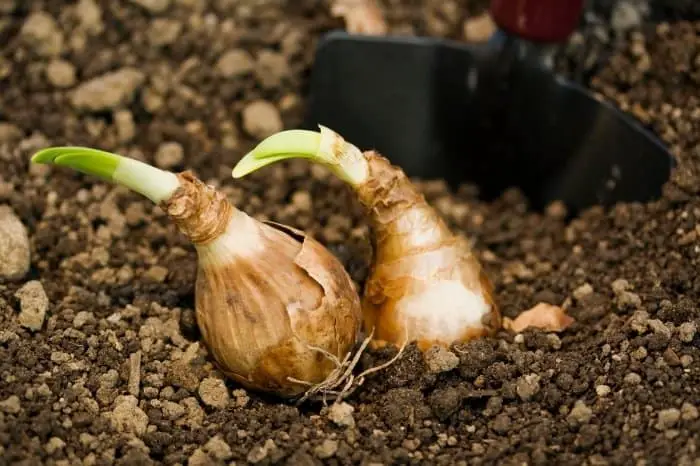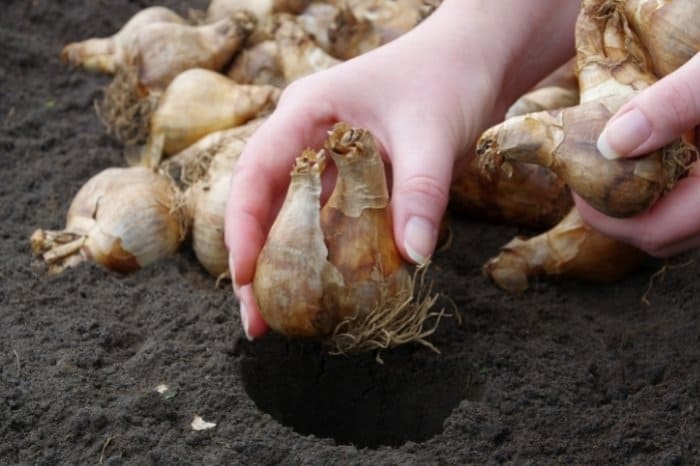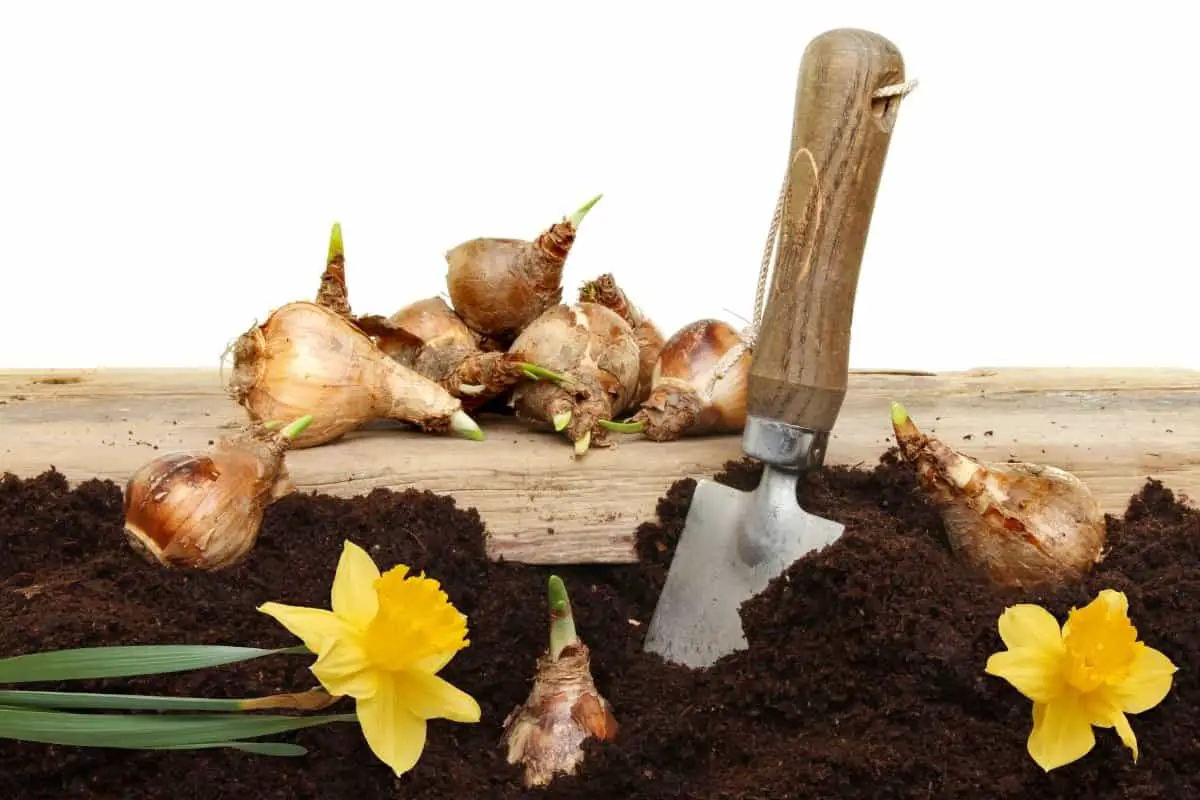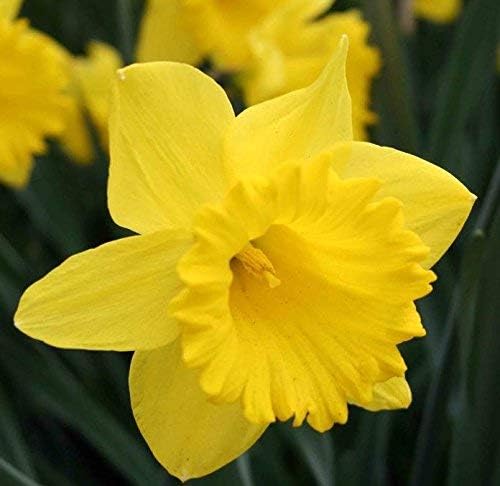Last Updated on February 15, 2022 by
How deep do you plant daffodil bulbs in your garden or pot to ensure they grow to give you a bounty harvest of your favorite flowers?
Daffodils are hardy and easy perennial flowers to grow in most parts of North America. They are propagated from a bulb in autumn so they can bloom late winter or early spring. The traditional daffodil flower is a yellow or white flower with 6 petals and a trumpet-like central corona but has many cultivated varieties.
The leafless stems bear between 1 to 20 flowers, and sometimes these flowers may need staking so that they don’t weigh down the stems. Daffodils are suitable for planting in a border, between shrubs, or for forcing blooms indoors. They are lovely in a woodland garden and large groves. They adapt well to most landscapes, making them one of a spring favorite. Bulb sizes range from small to large, with smaller bulbs measuring roughly an inch in diameter while average measures approximately 2 to 3 inches in diameter.
Daffodil Growing Requirements
Daffodils can grow as perennials in USDA plant hardiness zones 4 to 9. The best planting time is in the late fall in areas that experience low winter temperatures of at least -10 degrees.
When planting, use a fertilizer specially developed for bulbs, sprinkling it into the planting hole per the package label’s recommended amount. It is essential to consider the Daffodil bulb depth. What is the appropriate bulb planting depth and why?

How Deep To Plant Daffodils Bulbs
It is essential to plant your daffodils in the correct depth and manner. Plant your bulbs with the end facing up at least 3 or 4 times their height. This ensures that the weakest part of the plant’s stem is buried deeply enough to hold it upright throughout its blooming period.
Daffodil bulbs are best planted in September – November or the fall in well-drained soils. They will grow well in the sun or part shade.
Plant your daffodils anywhere in the garden in a free-draining situation, avoiding complete shade and proximity to south-facing walls. Here the soil temperature is likely to become uncomfortably hot for the bulbs.
Plant the bulbs twice as deep as the size of the bulb – at least 4 to 6 inches below the surface. For miniature daffodils, plant at twice the depth of the bulb and 3 to 5 inches apart.
How Deep Should I Plant Bulbs In Pots?
Daffodils also grow in pots, whether alone or combined with other spring flowers like pansies. When planting daffodil bulbs in pots, plant them at a depth of 4 to 7 inches below the soil’s surface.
Daffodils in pots should be planted more thickly than in the ground; make sure that the bulbs are not touching each other.
Dutch Master Daffodil Bulbs – Value 50 Bulb Bag – For Fall Planting
Why Plant Daffodil Bulbs Deep Enough?
Planting daffodil bulbs deep enough is a recipe for success. Once deeply planted, they germinate with lots of stamina, giving the plant a strong start all the way.
The other recipe is to select large, healthy daffodil bulbs that will produce the most potent flowers.
Wondering about Plant Bulbs? Click Here:
How To Plant Daffodil Bulbs
Daffodil bulbs can be planted in pots, planters, or a garden as long as adequate drainage. Ensure you provide them with compost or old manure when planting
If you live in USDA zones 4 to 6, you can grow your daffodils with no pressure. The best time to plant them is as soon as they are available in the early autumn. Plant your daffodils in groups of 10 or more by making a loose circle with about 7 bulbs and put 3 in the middle.
Don’t mix different cultivars within each planting group; the effect will be better if you plant one kind together and the other type-together.
These flowers look great in a formal garden setting with shapes like circles or squares. You can creatively form beautiful flower gardens with these flowers or mix them with others for a more satisfying look.
Steps For Planting Daffodil Bulbs
Plant your daffodil bulbs with the pointy end facing up and the fatter side facing down.
Plant your bulbs twice as deep as the bulb is tall. For example, if a bulb is 2 inches from the base to the tip, dig a 6-inch deep hole to put the bulb at 4 inches below the soil level.
Deep planting prevents frost damage to the bulbs protecting them from accidental damage from spades and rakes. You do not have to measure the hole; give it your best guess. The larger bulbs go more profound, and the smaller bulbs go closer to the surface.
If you grow your daffodils in sandy soil, plant them more deeply, while in clay or heavier soil, plant them in shallowly.
Cover your bulbs with enough soil and then water them appropriately. Mulch the area with chopped leaves, pine bark mulch, or whatever you usually use as mulch to help protect it from drying out.
Expect the garden daffodils to bloom in mid-spring in zones 6 and 7, but they will come sooner in a mild winter region for zones 8 and 9. This means they bloom later in colder areas than in hot seasons.

Growing daffodils is very easy and low maintenance. These flowers are reliable and will come back year after year. Combining them with other kinds of plants like perennials, annuals, and shrubs will make your garden livelier and interesting.
FAQs
Can you plant daffodil bulbs too deep?
If the bulb of a daffodil is planted in the ground, it will grow into a tall, strong, healthy plant. However, if the bulb is planted too deeply, it may not be able to develop and will look different than a normal daffodil.
Yes, daffodil bulbs can be planted too deeply. While there are exceptions, the general rule is that the bulbs should be planted at least 3 inches below the surface of the soil.
What happens if you don't plant daffodil bulbs deep enough?
If the bulbs are planted too shallow, they will not have enough room to grow roots and spread out. If you take a look at a photo of what a real daffodil looks like, it will help you understand. In order to get a good yield of bulbs, you must plant them deep enough so that they have room to grow.
How should you prepare the soil for planting daffodil bulbs?
For spring planting, the soil should be warm and fertile. If it is too cold, you can use a heated propagator to bring the soil temperature up. If the soil is too wet, drain it well. Soak the bulb roots in water for about 2 hours before planting. After planting, the bulbs must be protected from direct sun and wind.
Do daffodils multiply?
Yes, daffodils can multiply. It's not a problem as long as you know what to look for. When they start to bloom is when you will see the first signs of growth. The new shoots will be on the outside of the bulbs. This is also when you will see the leaves appear. As the spring progresses more and more shoots will appear. These shoots will grow and eventually turn into a flower.
Why are my daffodils falling over?
The answer to this question is complicated, and requires a bit of history. The daffodil was originally native to the Mediterranean region, and was brought to England by the Romans in the first century. It was introduced to North America around the mid-1800s, and is now one of the most popular spring flowers in the world.
Daffodils are perennial plants that have bulbous roots and grow between 3-4 feet tall. They are usually found in groups of three or four, and bloom for a few weeks each year. The problem with the daffodil is that it has an extremely shallow root system, and grows in a wide variety of soil types.
This means that you need to be very careful when planting daffodils. The soil in your garden should be evenly moist, but not soggy. You want to avoid standing water. If the soil is too wet, the roots will rot and the daffodil won’t grow properly.
If the soil is too dry, the daffodil will not bloom properly. The best time of year to plant a daffodil garden is in spring or early summer. This is when the flowers are in full bloom.
Final Thoughts
FAQs
Can you plant daffodil bulbs too deep?
If the bulb of a daffodil is planted in the ground, it will grow into a tall, strong, healthy plant. However, if the bulb is planted too deeply, it may not be able to develop and will look different than a normal daffodil.
Yes, daffodil bulbs can be planted too deeply. While there are exceptions, the general rule is that the bulbs should be planted at least 3 inches below the surface of the soil.
What happens if you don't plant daffodil bulbs deep enough?
If the bulbs are planted too shallow, they will not have enough room to grow roots and spread out. If you take a look at a photo of what a real daffodil looks like, it will help you understand. In order to get a good yield of bulbs, you must plant them deep enough so that they have room to grow.
How should you prepare the soil for planting daffodil bulbs?
For spring planting, the soil should be warm and fertile. If it is too cold, you can use a heated propagator to bring the soil temperature up. If the soil is too wet, drain it well. Soak the bulb roots in water for about 2 hours before planting. After planting, the bulbs must be protected from direct sun and wind.
Do daffodils multiply?
Yes, daffodils can multiply. It's not a problem as long as you know what to look for. When they start to bloom is when you will see the first signs of growth. The new shoots will be on the outside of the bulbs. This is also when you will see the leaves appear. As the spring progresses more and more shoots will appear. These shoots will grow and eventually turn into a flower.
Why are my daffodils falling over?
The answer to this question is complicated, and requires a bit of history. The daffodil was originally native to the Mediterranean region, and was brought to England by the Romans in the first century. It was introduced to North America around the mid-1800s, and is now one of the most popular spring flowers in the world.
Daffodils are perennial plants that have bulbous roots and grow between 3-4 feet tall. They are usually found in groups of three or four, and bloom for a few weeks each year. The problem with the daffodil is that it has an extremely shallow root system, and grows in a wide variety of soil types.
This means that you need to be very careful when planting daffodils. The soil in your garden should be evenly moist, but not soggy. You want to avoid standing water. If the soil is too wet, the roots will rot and the daffodil won’t grow properly.
If the soil is too dry, the daffodil will not bloom properly. The best time of year to plant a daffodil garden is in spring or early summer. This is when the flowers are in full bloom.
Daffodils can be left in the ground all year round without lifting or digging them up if you plan on growing them at the same spot again. Warm and wet soil causes bulbs to rot; therefore, you should dig them up instead of leaving them in such soil.
Daffodils need plenty of water to grow properly, a requirement that is easily met during rainy days. If there is no rain or limited rainfall, you will need to feed them with additional water up to an inch each week.
Mulching the bulbs with organic materials, such as pine needles, wood shavings, or shredded leaves helps keep the soil moist and acidic, which daffodils love. Above all, do not forget to plant those daffodil bulbs deep enough next time you grow yours.
Caroline is a gardener who loves to get down to the nitty–gritty of gardening. She proudly proclaims herself as a ‘dirt worshipper‘ and can often be found deep in the garden, covered in soil and singing to her plants. As a self–proclaimed ‘plant whisperer‘, Caroline believes that plants need love and attention just like any other living thing, and she loves to give them both. When she‘s not tending to her garden, you can often find her researching the latest gardening trends, or teaching others how to make their gardens thrive



